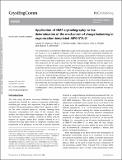Files in this item
Application of NMR crystallography to the determination of the mechanism of charge-balancing in organocation-templated AlPO STA-2
Item metadata
| dc.contributor.author | Seymour, Valerie Ruth | |
| dc.contributor.author | Eschenroeder, Eike Christian Viktor | |
| dc.contributor.author | Jimenez-Castro, Maria | |
| dc.contributor.author | Wright, Paul Anthony | |
| dc.contributor.author | Ashbrook, Sharon Elizabeth | |
| dc.date.accessioned | 2013-07-29T16:01:03Z | |
| dc.date.available | 2013-07-29T16:01:03Z | |
| dc.date.issued | 2013-07 | |
| dc.identifier | 61448635 | |
| dc.identifier | f54565c6-0898-4020-a6d8-5600dcf492f6 | |
| dc.identifier | 84885582670 | |
| dc.identifier.citation | Seymour , V R , Eschenroeder , E C V , Jimenez-Castro , M , Wright , P A & Ashbrook , S E 2013 , ' Application of NMR crystallography to the determination of the mechanism of charge-balancing in organocation-templated AlPO STA-2 ' , CrystEngComm , vol. Advance . https://doi.org/10.1039/C3CE40965A | en |
| dc.identifier.issn | 1466-8033 | |
| dc.identifier.other | ORCID: /0000-0002-4538-6782/work/56638953 | |
| dc.identifier.other | ORCID: /0000-0002-4243-9957/work/62668283 | |
| dc.identifier.uri | https://hdl.handle.net/10023/3890 | |
| dc.description.abstract | The combination of solid-state MAS NMR spectroscopy and first-principles calculations is used to elucidate the structure of an as-prepared microporous AlPO (STA-2), in which the organocation template (bis-diazabicyclooctane-butane) is charge balanced by hydroxyl groups coordinated to framework aluminium species. 27Al MAS NMR spectra show Al exists in both tetrahedral and five-fold coordination, with the latter directly coordinated to hydroxyl O atoms as well as framework O atoms. The relative intensities of these resonances can be used to determine that the hydroxyls bridge between the two types of Al. Calculation of NMR parameters using a periodic density functional theory approach are able to suggest assignments for the resonances in both 27Al and 31P NMR spectra. 31P chemical shifts are shown to depend not only on the topologically-distinct sites in the SAT framework but also on whether or not the P atoms form part of a six-membered P(OAl)2OH ring, where OH is a bridging hydroxyl. By diffraction six possible sites for the charge-balancing hydroxyls have been identified, but all are refined with an average occupancy of 0.33. However, predicted peak positions in two-dimensional J-HETCOR NMR spectra indicate that only one hydroxyl is found in each cancrinite cage, and suggest that the most likely arrangements are those that avoid the close approach of bridging hydroxyl groups in adjacent cages. We show that the use of a combination of NMR spectroscopy and calculation to elucidate structure, often referred to as “NMR Crystallography”, offers a promising route for the future study of as-made and substituted microporous materials. | |
| dc.format.extent | 12 | |
| dc.format.extent | 1056475 | |
| dc.language.iso | eng | |
| dc.relation.ispartof | CrystEngComm | en |
| dc.subject | QD Chemistry | en |
| dc.subject | DAS | en |
| dc.subject.lcc | QD | en |
| dc.title | Application of NMR crystallography to the determination of the mechanism of charge-balancing in organocation-templated AlPO STA-2 | en |
| dc.type | Journal article | en |
| dc.contributor.sponsor | EPSRC | en |
| dc.contributor.sponsor | EPSRC | en |
| dc.contributor.sponsor | EPSRC | en |
| dc.contributor.sponsor | EPSRC | en |
| dc.contributor.sponsor | EPSRC | en |
| dc.contributor.institution | University of St Andrews. School of Chemistry | en |
| dc.contributor.institution | University of St Andrews. EaSTCHEM | en |
| dc.identifier.doi | https://doi.org/10.1039/C3CE40965A | |
| dc.description.status | Peer reviewed | en |
| dc.identifier.grantnumber | EP/E041825/1 | en |
| dc.identifier.grantnumber | EP/J501542/1 | en |
| dc.identifier.grantnumber | EP/J501542/1 | en |
| dc.identifier.grantnumber | EP/F018096/1 | en |
| dc.identifier.grantnumber | EP/J501542/1 | en |
This item appears in the following Collection(s)
Items in the St Andrews Research Repository are protected by copyright, with all rights reserved, unless otherwise indicated.

